Welcome to the first Escapist Cover Story! This is a new project for us here where we combine big exclusive hands-on previews with a mini-documentary to deliver both new information about upcoming games along with the human angle side of the story. We hope you like this first edition, focusing on Darksiders Genesis from Airship Syndicate! Be sure to not miss the documentary piece in the featured image slot above.
Nick Calandra
Editor-in-Chief
Airship Syndicate’s Darksiders Genesis is firmly rooted in the series’s past. The plot is set well before the events of the original 2010 hack-and-slash action adventure game, foreshadowing the conflict that would lead to the apocalypse, and while the camera angle may have changed, much of the game’s mechanics also hearken back to past titles.
War, the brooding, sword-wielding Horseman of the Apocalypse who starred in Darksiders, is back and still voiced by Liam O’Brien. You’ll recognize his moves when he’s mounting up on Ruin and trailing fire behind him as he rides into battle, transforming into a hulking demon in Chaos form, gliding across a chasm using Shadowflight, or swinging around using the Abyssal Chain.
“All of War’s animations are new, but they’re based off his original combos,” said Airship Syndicate design director Steve Madureira. “It’s a little faster paced than Darksiders, but maybe a little slower than Death’s combos in Darksiders 2. We really wanted to make sure when people play it, it feels like Darksiders.”
When Vigil Games’ parent company THQ declared bankruptcy in 2012, many of the Austin-based studio’s core employees split up between Gunfire Games and Airship Syndicate. The Darksiders franchise fractured with them. Series co-creator and Airship co-founder Joe Madureira (Steve’s brother) had almost no part in the Gunfire-developed Darksiders III and had to stay quiet when fans asked what he was doing since he was already working on Genesis.
The challenge was how to develop a Darksiders game with a much smaller studio. While Airship Syndicate has grown to about 30 people, work on Genesis started with the same nine-person team that created Airship Syndicate’s first game, the turn-based RPG Battle Chasers: Nightwar. Using a top-down perspective was one of the keys.
“The camera is conducive to a smaller team since you have to build out less of the world and it’s comfortable for aiming and firing,” Steve said.
Hack-and-slash meets twin-stick shooter
That last part is necessary for the series’s newest playable Horseman, Strife, who wields a pair of handguns. One player can control each character in online multiplayer or a single player can swap between the characters, alternating between War’s classic hack-and-slash feel and Strife’s twin-stick shooter controls.
“He’s less like a hulking brute; he’s more like an agile ninja,” Steve said. “Gameplay-wise he has a higher skill ceiling. He has less health than War, but you have tools to keep enemies away.”
While Strife is capable of a light melee attack, he lacks War’s ability to block and counter attacks, so his health will quickly plummet when cornered. Luckily he has the ability to dash away when the odds are stacked against him. Like in past games, the Horsemen have a set of Wrath abilities that are powered up by collecting souls from fallen enemies, and one of Strife’s powers allows him to conjure shadow duplicates of himself that can distract enemies. Strife also has a hot streak meter that fills through consecutive hits, giving extra kickers to his shots based on what ammo he’s using, like allowing his static shot to chain to more enemies.
Strife is constantly poking fun at War, whether it’s pointing out how inconvenient his heavy armor is when jumping around or goading him when they’re forced to take a more surreptitious approach to a giant battle. The dialogue happens at scripted moments in battle or exploration, though there are also spots throughout the game where two Horsemen can sit down for some brotherly conversation.
“The tone of the story is a little lighter with a lot more humor,” Joe said. “The tone of the other games were getting progressively darker, so it seemed like the natural way to go. Strife’s a bit more lighthearted. Because it’s multiplayer, having fun banter is more enjoyable.”
Most active and passive abilities in the game are powered up by collecting resources. Healthstones increase your character’s max health; potion upgrades can add kicker effects to consumables like letting you recover Wrath when you heal or even automatically healing you when you would die. Both Horsemen unlock a total of six different weapon attacks, three Wrath moves, and special equipment needed to solve the game’s puzzles.
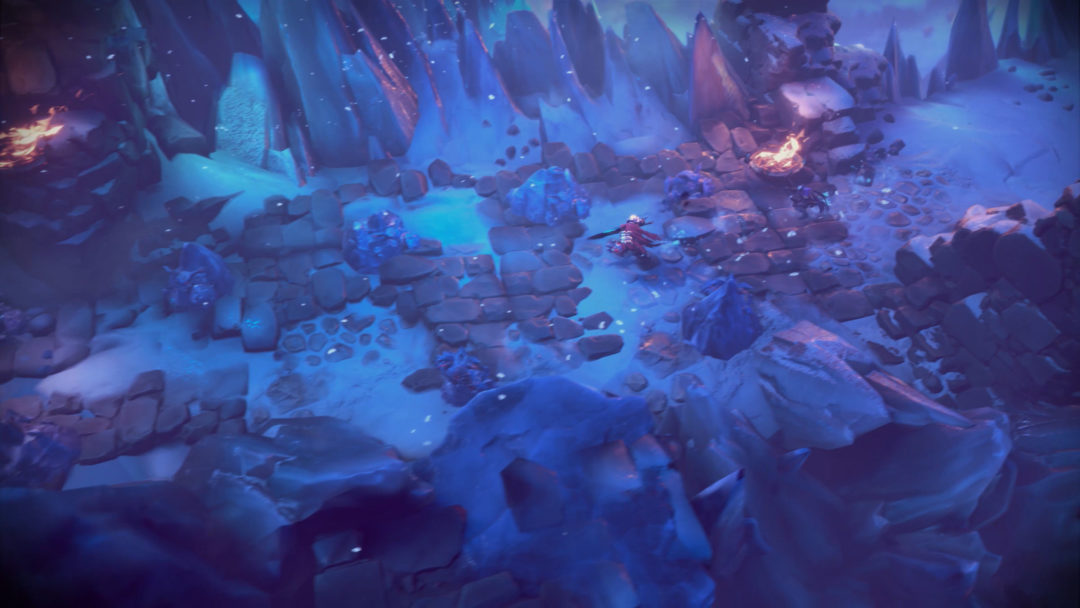
“We reward exploration,” Steve said. “A lot of things are hidden throughout. Secrets, puzzles. The structure of the game is mission-based, so you can replay a mission and look for stuff you missed the first time.”
In fact, most levels in Darksiders Genesis can’t be fully cleared the first time you play through since you’ll need to return with items that let you access previously impassable areas of the map. We got a first look at the game’s fourth level, Icewind Cavern, which emphasizes one of War’s unique items: an oversized shuriken he can angle and throw between pyres to spread that fire to beacons. In Icewind Cavern, he must light four of these beacons to remove a barrier that lets you explore the rest of the level.
The frozen wasteland is fairly open, giving War and Strife the freedom to ride around the map, dispatching swarms of minor enemies from horseback. Creatures seem to burrow up from the ground or burst out of ice crystal. Occasional wards force you off your horse until you can solve a puzzle or dispatch a particularly nasty foe, like a creature whose light blue spikes let it blend into the terrain until it’s lashing at you with claws and its tail. Gnarled roots creep out of some of the architecture, while other structures are ominously decorated by dangling chains. The level also features an optional puzzle using Strife’s void bombs, which he can throw to open portals to areas that would otherwise be inaccessible. Even once you’ve solved the puzzle, you then have to make some complex jumps to get a collectible.
I actually had more fun playing through the game’s first level, which serves as a sort of tutorial for the various traversal and combat techniques. It also has plenty of optional rewards for those who are more skilled than I am at complicated jumping, and while watching me play Steve made notes about an air vent he wants to add more lift to and the possibility of letting players pick up Creature Cores, the primary resource of the game’s upgrade system, without dismounting. I spent most of the level on horseback shooting down enemies like a cosmic cowboy. I struggled with some of the traversal areas a bit, but luckily the penalty for death is just to respawn nearby.
The level ends with a fight against the mini-boss the Hollow Fiend, which is based on one of the very first character designs the team created when pitching the original Darksiders. Rising out of a chasm, the giant demon has an insectoid appearance and shows off the designers’ effort to make sure that both Horsemen are equally useful and challenged in combat.
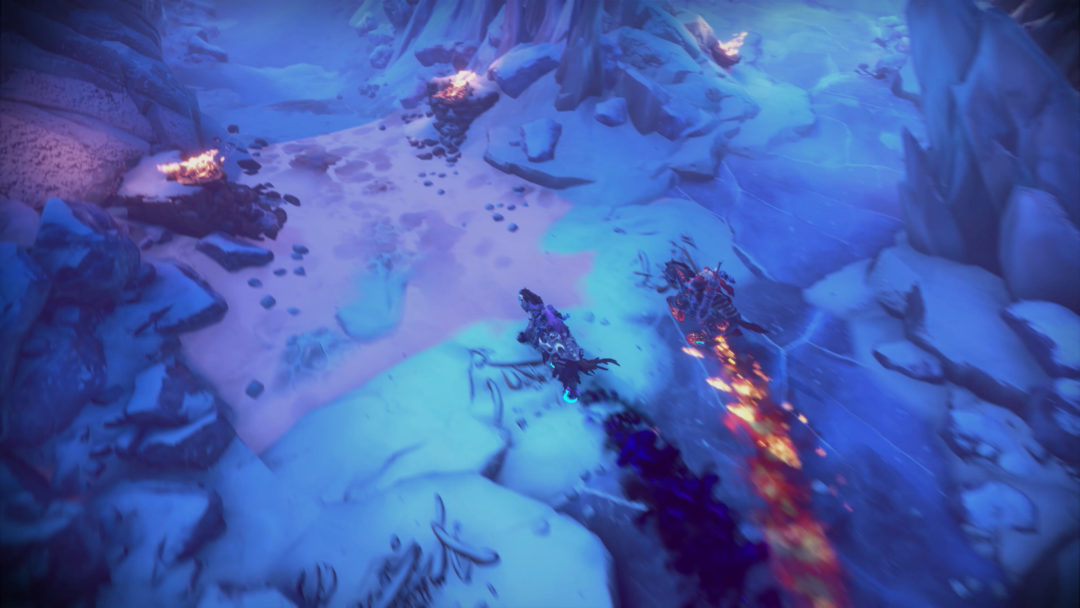
You can’t pick favorites
I first thought Strife would be the ideal combatant for the boss since he could stand at the back of the platform and fire on the Fiend from outside of the reach of its massive claws, but there I had to contend with a series of detonating fireballs. I fared better in melee, with aggressive use of War’s ability to dash out of range of the Fiend’s claws while dealing blows to his core. When small demons start spawning as the Fiend’s health gets lower, they’re as much a boon as they are a nuisance. When you get an enemy’s health low enough you can perform a flashy finishing move that renders you momentarily invulnerable, and timing those attacks can serve as another form of block or dodge when a boss is about to lay into you.
The Hollow Fiend’s damage is being toned down for release, but I enjoyed the challenge of dispatching him as is. If a Horseman’s health is reduced to zero during a boss fight when fighting solo, you immediately swap to the other Horseman and the one you were initially playing goes on cooldown. If you can endure long enough, you can swap back, though you’ll be at low health and probably want to pop a potion as soon as possible. In multiplayer, the surviving player just has to fight alone until their dead ally’s cooldown ticks down. If you’re killed while your ally is still on cooldown, you have to restart.
It took me three tries, but the victory was exciting and the process gave me a much better handle on both characters’ combat styles. The controls are both nuanced and intuitive, rewarding you for maintaining strong situational awareness and responding with the right action. This can mean dashing away from an attack, smashing everything in the area with War’s Blade Geyser, or timing the use of Chaos form for maximum effectiveness.
Button mashing will get you through minor enemies, but you’ll need finesse for mini-bosses and bosses. The team has succeeded in their goal of ensuring Darksiders Genesis still feels like the series third-person action games by giving you a huge variety of options that must be used tactically. For instance, you can map two different types of ammo to Strife’s controls. This allows him to seamlessly swap between more straightforward damaging attacks best for dispatching weak foes and ones that steadily become more powerful that are useful for longer fights. If those aren’t cutting it, you can quickly call up a wheel of ammo types and change the mapping to something like a void shot, which sucks all the enemies into a mini-black hole and leaves them vulnerable to an AOE attack. Dis, a new vendor who hangs out in the same between-levels hub as the shady demon merchant Vulgrim, sells combo moves to add even more depth to the system.
“(Darksiders Genesis) definitely leans more towards combat, though there’s some puzzle solving and some traversal too,” said Airship Syndicate president and Darksiders co-creator Ryan Stefanelli. “Darksiders I and II, we really just tried to turn all three of the knobs up to 11. Here we tried to focus our efforts a little more on the combat system.”
The puzzles also change based on whether you’re alone or with a friend. At the most basic level, this can be just changing from pulling a single lever to requiring both players to pull them simultaneously, but it can also involve one player disabling a trap while the other anxiously listens to a timer ticking down to when it will reset as they try to complete the jumps, shimmying, or other tasks needed to make an area passable for both players.
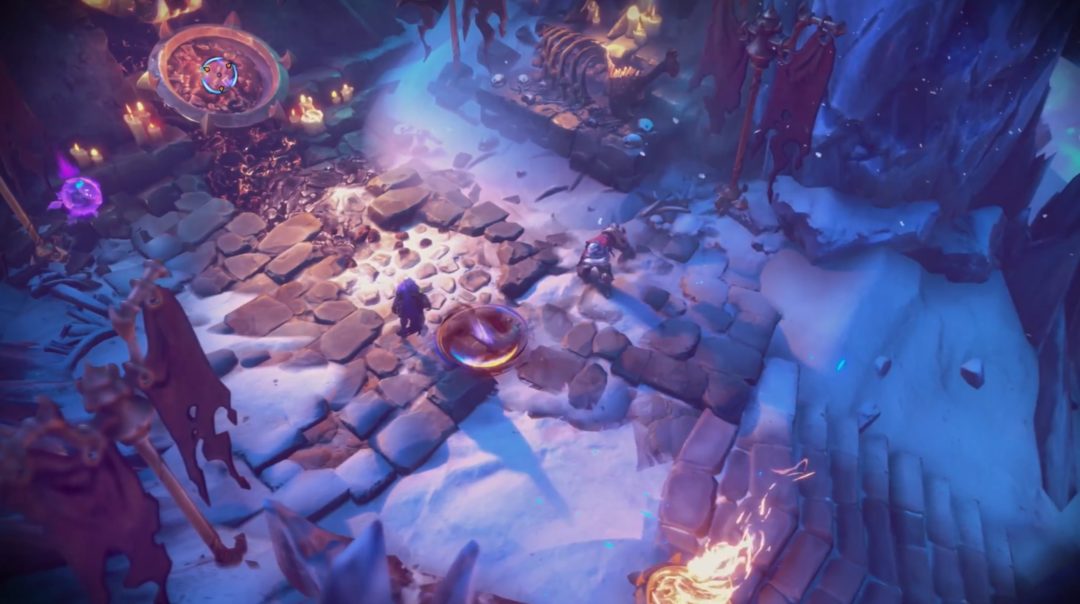
An ‘arcadey Darksiders experience’
Darksiders Genesis has a total of 11 levels and five boss fights, each of which can be replayed as often as you want to grind resources or return for anything you missed. Each one also has a recommended power level, so you can check to see if your gear is up to snuff before going in.
“It’s a very arcadey Darksiders experience,” Stefanelli said. “When we were thinking about how we want to approach what we show the players versus tell the player, we thought it would make it a more interesting experience to tell players exactly what they failed to acquire so they know, ‘I have to go back and find this chest and some Boatman Coins and I’m missing an ammo type.”
The primary resource players will need to grind are Creature Cores, dropped by each of the game’s monsters. You won’t find new weapons and armor throughout the game like in Darksiders II, instead leveling up your abilities by slotting in Cores that have different effects themed to the creatures they came from. The Cores apply to both Horsemen, though they’ll have different effects based on their abilities, to make sure you don’t need to spend time changing gear when you swap characters. It also ensures that characters are on a level playing field in multiplayer.
Airship Syndicate initially planned for Darksiders Genesis to take about 10 hours for a main playthrough and 15-20 hours for completionists, but the main game grew to about 15 hours. That number can be more or less depending on how much time players spend racing through levels on horseback versus walking around and taking in every detail. You can play on casual, normal, or hard mode initially, with an Apocalyptic difficulty unlocking after a successful playthrough.
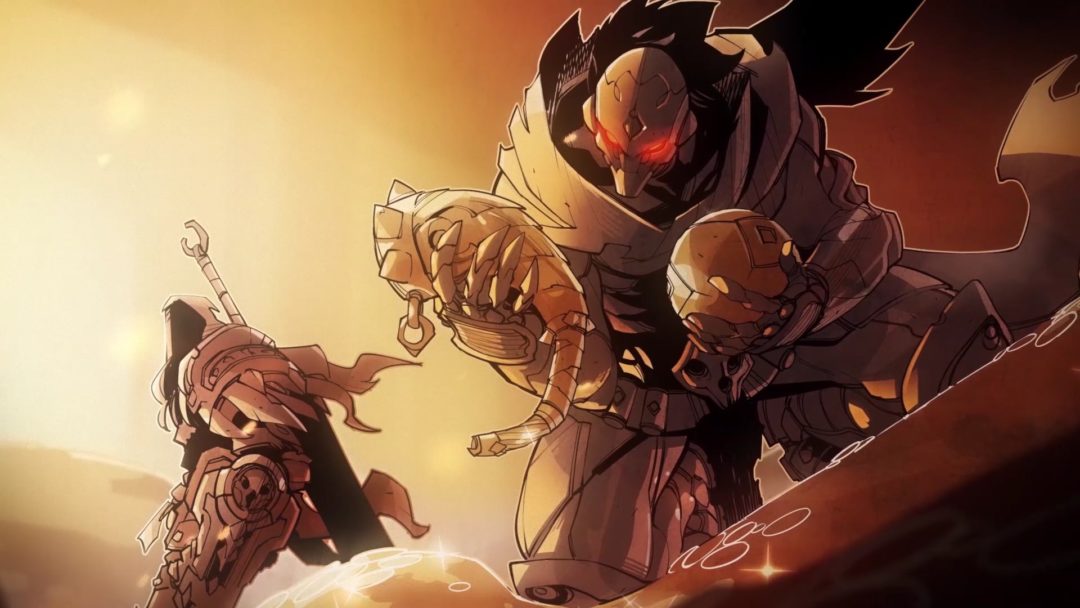
Gunfire Games provided technical consultation for Airship Syndicate, helping the studio transition between Unity and the Unreal Engine. They also made sure that Darksiders Genesis wouldn’t mess with the series’s continuity as it throws in numerous callbacks.
“We called it Darksiders: Rogue One,” Joe said. “It’s part of the story and kind of off to the side. It sets up a lot of the events for the other games, so that’s cool if you’ve played them. If you haven’t, it reintroduces things.”
While the mechanics of Darksiders are perpetually fresh for the developers, they confessed they did have to visit the game’s wiki to remind themselves of the story and check the names.
“We don’t even know the names of half the creatures,” Stefanelli said. “You get so used to using the internal names for levels, creatures, everything. At the end of the game you realize, ‘We can’t call it the elite demon. We’ve got to give it a cooler name than that.’”
As Darksiders Genesis approaches its Dec. 5 PC and Google Stadia release and Feb. 14 arrival on consoles, Airship Syndicate is already working on two new projects, one of which might be ready to announce by the end of the year. The studio has tripled in size since its founding, and the journey back into Darksiders‘ past is just another step into their ambitious future.

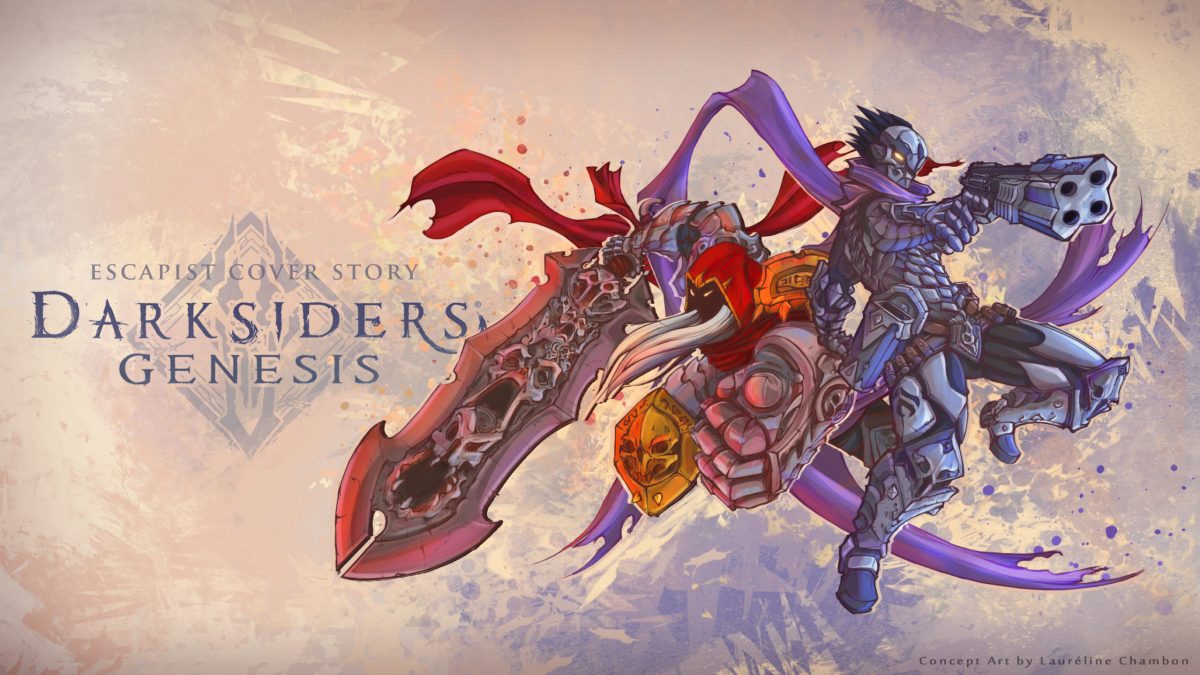




Published: Nov 25, 2019 12:00 pm